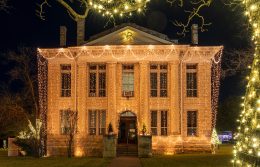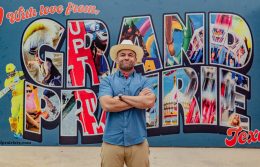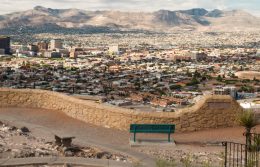Traveling the East Texas Music Highway
Austin owns the title of Texas’ musical capital. Houston has given the world its unique, influential take on R&B and hip-hop. San Antonio helped birth Tejano culture. And Dallas-Fort Worth produced some of the world’s most popular artists, from Norah Jones to Erykah Badu. But the real roots of Texas music run deep in the red clay dirt of East Texas.
East Texas’ musical heritage is steeped in the country blues that emerged out of African-American sharecropping communities and the country singer-songwriters who grew up in the region’s small towns. Today, much of this musical heritage is still on display in the land that blends country, Cajun, Southern, and Western cultures.
Across the Eastern Border
Our journey begins just a few miles east of the Texas border at Shiloh Baptist Church in Mooringsport, Louisiana, a short drive from the tiny town of Linden, Texas. Here you can find the gravesite of one of Texas’ most influential musical pioneers, Huddie William “Lead Belly” Ledbetter. Lead Belly was born in Mooringsport, lived a hard-worn life, endured a few stints in jail, and made some of the most influential recordings of folk, blues, and Americana of his time.
Linden
Linden is also the birthplace of T-Bone Walker, who would move to Dallas and earn the alias “Oak Cliff T-Bone” after the neighborhood next to the Trinity River where he began his performing career.
Carthage
From here, travel south on Route 59 toward Carthage, the home of the Texas Country Music Hall of Fame. The museum celebrates the many Texans who have contributed to the development of the state’s particular brand of country music and hosts the Texas Country Music Hall of Fame Country Music Festival each August. While in town, don’t miss the Jim Reeves memorial, which is dedicated to Texas’ native son who helped develop the Nashville sound.
Big Sandy
The next stop is the tiny town about 63 miles west of Carthage. On the way, you’ll pass through Longview, the birthplace of country star Miranda Lambert. Big Sandy is the hometown of one of the originators of the blues, “Ragtime Texas” Henry Thomas. Thomas was born in 1874, and the recordings he made in the 1920s demonstrate how the popular music of the turn of the century blended with the history of the South to give birth to the blues.
Tyler
The next stop is determined by when you are traveling. If it’s April, Tyler is the spot to go; every year the town hosts the Texas Blues Festival, a noon-till-midnight extravaganza attracting internationally known artists and honoring Texas blues pioneers such as Blind Lemon Jefferson and Walker, and Jimmie and Stevie Ray Vaughan.
Athens
Just down the road, you’ll find the Old Fiddlers Contest and Reunion held each May on the courthouse lawn, where fiddlers reunite, a carnival takes over the sidewalks, and a famous street dance reigns all night.
Corsicana
Heading a little farther west, our journey brings us to the Lefty Frizzell Museum. The museum celebrates the Corsicana native whose chart-topping country hits in the 1950s helped influence some of the biggest names in Texas country music, including George Jones, Willie Nelson, and Roy Orbison.
Wortham
Turning south, routes 14, 84, and 287 pass through a series of tiny towns that were the birthplace of some of the originators of the Texas blues. Jefferson was born and preached in a small town near Wortham called Coutchman (now a ghost town) before moving to Dallas to make his name as a guitar singer on the streets of Deep Ellum.
Centerville
Nearby Centerville is where Lightnin’ Hopkins was born. The farm laborer’s prolific recordings, mostly made in Houston, helped turn him into one of the most influential guitarists in music history.
Crockett
The town where Hopkins also lived has erected a statue in commemoration of the ax-slinger, and in September the town will host its annual World Championship Fiddlers Festival.
Navasota
To see what the world looked like when the sharecroppers and sons of former slaves began taking spirituals, work songs, vaudeville tunes, and country folk music and blending them into the blues, head southwest on routes 21 and 90 toward Navasota.
Washington-on-the-Brazos
Mance Lipscomb, considered one of the originators of the Texas blues, was born in the nearby hamlet of Washington-on-the-Brazos, and he worked at the Allen Farm, a 20,000-acre cotton plantation and prison farm run by the notorious Tom Moore, who was immortalized in Lipscomb’s “Tom Moore Blues.” Follow the Allen Farm Road and you can see remnants of the shotgun shacks that housed the workers, some with the hated name “Tom Moore” still etched in faded white paint on the sides.
La Grange
Our journey wraps up with something of a cultural detour. About an hour’s drive to the southwest of Allen Farm is La Grange, home to the Texas Czech Heritage and Cultural Center. The center preserves the heritage and culture of the immigrants who came to Texas in the 19th century, bringing polka with them. Descendants of Czech, Polish, and German Texans keep the still-lively Texas polka scene as robust as ever.
The imported three-four rhythms also helped shape the sound of Conjunto and Tejano. That musical story is a testament to the richness and diversity of the East Texas musical landscape.
Want to hear some of the sounds mentioned here? Check out our ultimate road trip playlist of music by Texans, for Texans.
© 2018 Texas Farm Bureau Insurance



